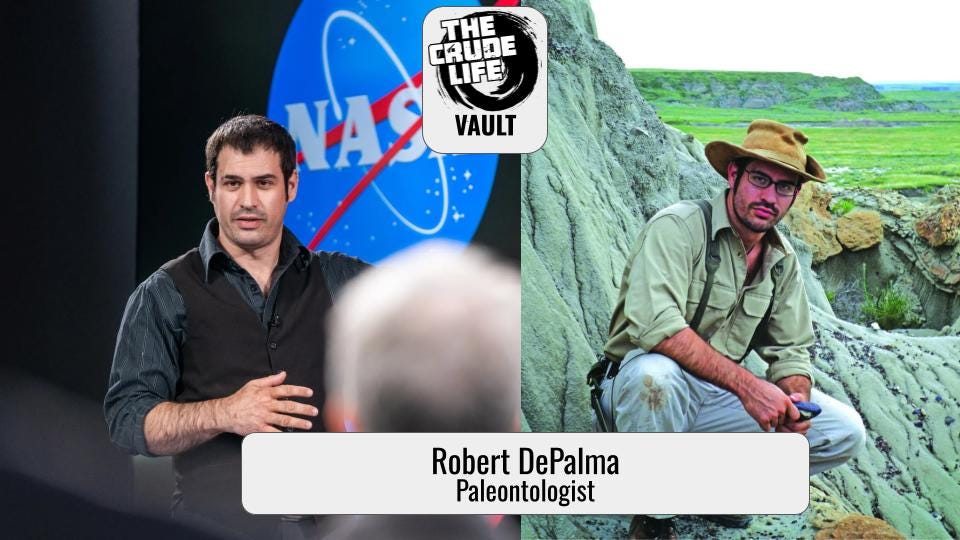Robert Depalma, paleontologist, describes the meteor impact 66 million years ago that generated a tsunami-like wave in an inland sea that killed and buried fish, mammals, insects and a dinosaur, the first victims of Earth’s last mass extinction event.
The death scene from within an hour of the impact has been excavated at an unprecedented fossil site in North Dakota. This was the subject of an engaging hour-and-a-half for both paleontologists and NASA researchers.
Paleontologist Robert DePalma gave a guest talk at NASA’s Goddard Space Flight Center in Greenbelt, Maryland. DePalma discussed his team’s excavations in North Dakota and shared findings they tie to an asteroid strike off the coast of present-day Mexico that led to the mass extinction of the dinosaurs and many other lifeforms 66 million years ago.
“The way a lot of us at Goddard started thinking of this was the collision, quite literally, between space science and Earth,” said Goddard Deputy Center Director Anne Kinney. Because of that overlap of scientific fields, a panel of Goddard scientists with expertise ranging from astrophysics, to planetary science, climate, and hydrology met with DePalma after his presentation for a discussion of the findings.
“Science is a community activity,” said Goddard Chief Scientist Jim Garvin. “When connections and science come together and paint a bigger picture than any one line of thought, that’s exciting, that’s thrilling. We all, as scientists, hope for that.”
DePalma presented as a guest of the Goddard Scientific Colloquium, which has brought outside researchers to the center since 1965, to discuss all manner of compelling topics. Past presenters have included the likes of astronomer Carl Sagan, physician Anthony Fauci, and hundreds of other experts.
To accompany DePalma’s lecture, his team brought preserved fossils of fish, footprints, amber, and triceratops skin from the North Dakota dig site, known as Tanis.
“The really exciting thing was, you don’t often get to touch the past,” Kinney said. “To see it right there in front of you, it makes history so personal. … It is 66 million years ago, but it’s right there in front of you at the same time.”
“I think for me the moment of, ‘Oh my gosh – we’re not in Kansas anymore,’ was when Robert showed these little preserved glass spheres,” Garvin said. Tektites, as scientists call these small and often beadlike bits of vaporized rock, are common byproducts of impact events, both on Earth and on other worlds.
According to DePalma and his team, tektites from the dinosaur-ending collision off Mexico’s Yucatán Peninsula became lodged in the gills of fish: the force of the impact was strong enough to wash marine life some 3,000 miles north to present-day North Dakota, where DePalma and his team excavated an unusual fossil jumble of saltwater and freshwater fish along with land-dwelling dinosaurs.
If DePalma and his team are right and these tektites contain remnants of the asteroid itself, “This example of what might be a little tiny fragment, maybe micrograms, of the colliding asteroid – the fact that a record of that is preserved, would be mind-blowing,” said Garvin, who has studied impact cratering on Earth and Mars extensively.
The conversation around DePalma’s research highlighted how events in space can affect life on Earth. That interconnection is one of the many reasons why NASA studies the solar system so extensively.
“We are in space together, and connecting life on Earth to asteroid impacts is part of our history,” Garvin said. “That is very cool.”
Interview from April 2019
During Earth Month, The Crude Life highlights the oil and gas industry's efforts to promote environmental awareness through various initiatives. The platform emphasizes the sector's commitment to sustainability by showcasing practices such as land reclamation and habitat restoration, which aim to preserve natural ecosystems affected by industrial activities.
Additionally, The Crude Life underscores the industry's focus on carbon awareness, advocating for sustainable solutions, community engagement and encouraging ethical energy. By featuring these stories, interviews and endeavors, The Crude Life illustrates how the oil and gas industry actively contributes to environmental stewardship and awareness during Earth Month.
Everyday your story is being told by someone. Who is telling your story? Who are you telling your story to?
Email your sustainable story ideas, professional press releases or petro-powered podcast submissions to thecontentcreationstudios(AT)gmail(DOT)com.
#thecrudelife promotes a culture of inclusion and respect through interviews, content creation, live events and partnerships that educate, enrich, and empower people to create a positive social environment for all, regardless of age, race, religion, sexual orientation, or physical or intellectual ability.
CLICK HERE FOR SPECIAL PARAMOUNT + DISCOUNT LINK
All Paramount+ subscribers can watch golf's most prestigious tournament with Masters Live!
Experience The Masters through a series of live feeds focused on pivotal players or holes at Augusta National Golf Club. Check out what's on the agenda for this year:
Masters on the Range
Holes 15 & 16
Featured Groups
Amen Corner
And more!
Be sure to get ready for the third and final rounds with Paramount+ Expanded Coverage starting at 12PM ET! Preview what's to come with legendary play-by-play broadcaster Jim Nantz and the rest of the CBS team.

















Share this post